#tewodros II
Text

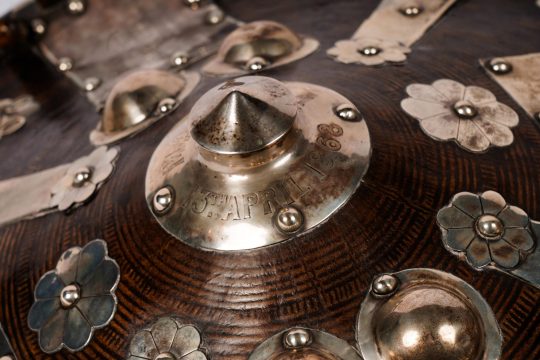
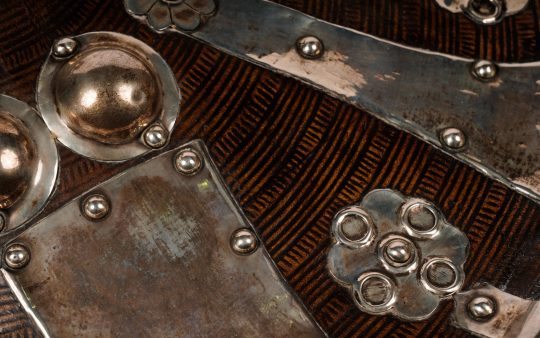
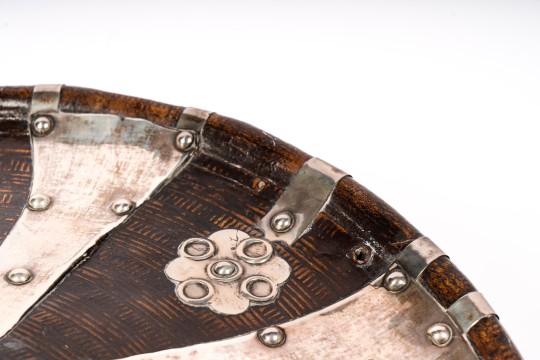
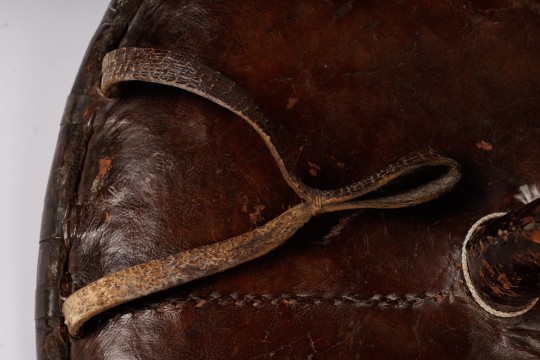

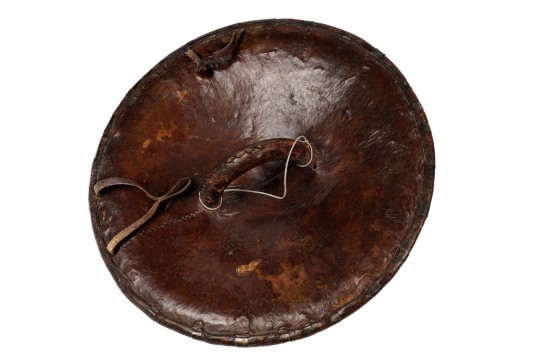
A 19th Century Abyssinian shield,
The circular dome shield made from hide and decorated in blind, with white metal strapwork and floral appliquets, the central boss engraved description "Magdala 13th April 1868", the reverse with carrying handle,
52cms diameter.
Lord Napier led the expedition of 1868 against Emperor Tewodros II of Abyssinia (modern day Ethiopia). The Abyssinian ruler was holding a number of Protestant missionaries hostage, in his mountain capital of Magdala, as well as two British diplomats who had attempted to negotiate their freedom.
After months of planning, the advance guard of engineers landed at Zula on the Red Sea to constuct a port on 30th October 1867; Napier himself arrived in Zula 2nd January 1868, on the 25th January 1868 Napier led his group south to Ethiopian highlands.
After traversing 400 miles of mountainess terrain in inhospitable weather, Napier's troops reached the foot of Magdala on the 9th April 1868, and the next day, defeated the 9000 troops still loyal to Tewodros at the battle of Magdala for the loss of only two British lives.
Although Emperor Tewodros II surrender his hostages and made repeated efforts for a negotiated surrender, the distrustful Napier pressed on and ordered an assault on the mountain redoubt on 13th April 1868. The British captured Magdala and Emperor Tewodros killed himself. Napier then ordered the destruction of Tewodros' artillery and the burning of Madgala as retribution. This included the expedition and its troops looting many local artifacts which they took back to Britian.
Napier was elevated to the peerage as Baron Napier of Magdala on 11th July 1868 and granted annuity and ammunity for life.
Courtesy: Anderson and Garland
#art#history#design#style#sculpture#antiquity#19th century#imperial#africa#african history#african heritage#tewodros II#magdala#shield#abyssinian#ethiopia#colonialism#colonial violence#napier#anderson&garland
39 notes
·
View notes
Text
Dejazmatch Alemayehu Tewodros, Prince Alemayehu/Alamayou of Ethiopia (23 April 1861 – 14 November 1879)
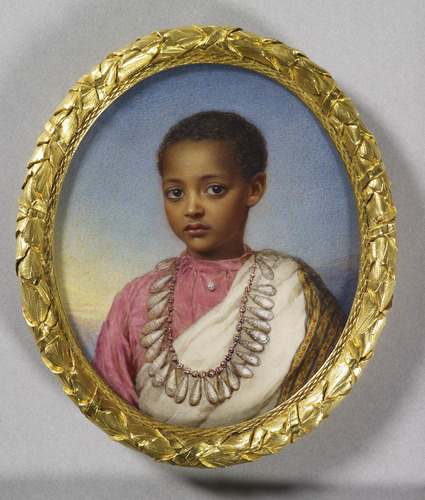
Reginald Easton (1807-93) 'Alamaiou, aged 7 years, son of Theodore, King of Abyssinia' Inscribed 1868
Dejazmatch Alemayehu Tewodros, often referred to as HIH Prince Alemayehu or Alamayou of Ethiopia (23 April 1861 – 14 November 1879) was the son of Emperor Tewodros II of Ethiopia. Emperor Tewodros II committed suicide after his defeat by the British, led by Sir Robert Napier, at the conclusion of the British Expedition to Abyssinia in 1868. Alemayehu's mother was Empress Tiruwork Wube.
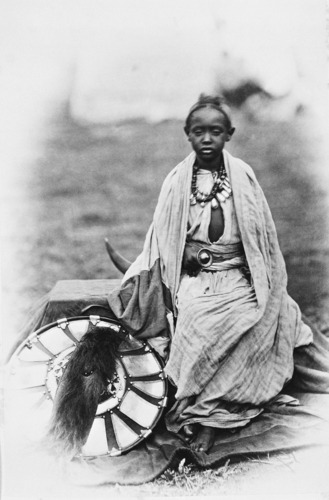
Prince Alamayou, son of King Theodore, from album 'Expedition to Abyssinia, 1867–68' April-May 1868
After the Battle of Magdala, the young prince was taken to Britain, under the care of Captain Tristram Speedy. This decision was apparently made in the fear that the Prince's life would be in jeopardy from an aspirant for the Empire of Abyssinia. Upon the arrival of the little Prince's party in Alexandria, Speedy dismissed the entire Ethiopian entourage of the Prince much to their distress and they returned to Ethiopia.
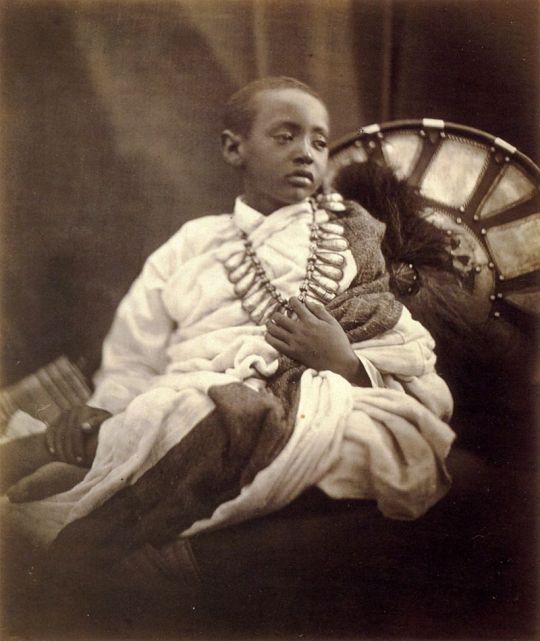
Prince Alemayehu, as photographed by Julia Margaret Cameron at the Isle of Wight in 1868.
While staying at Speedy's home on the Isle of Wight he was introduced to Queen Victoria at her home at Osborne House. She took a great interest in his life and education. He died at the age of 18 in 1879. Queen Victoria mentioned the death of the young prince in her diary, saying what a good and kind boy he had been and how sad it was that he should die so far from his family. She also mentioned how very unhappy the prince had been, and how conscious he was of people staring at him because of his colour.

Prince Alemayehu as a young man. Photograph by Edward Hall Speight of Rugby.
Queen Victoria arranged for Alamayehu to be buried at Windsor Castle. A brass plaque in the nave of St George's chapel commemorates him and bears the words "I was a stranger and ye took me in", but Alamayehu's body is buried in a brick vault outside the chapel. In 2007, the Ethiopian government requested the return of Alemayehu's remains for reburial in Ethiopia.
#alemayehu#ethiopian history#queen victoria#british colonialism#british empire#Victoria: May Blossom of Britannia#prince alemayehu
16 notes
·
View notes
Text
Who are the Negas

The Negas were a group of people who lived in Ethiopia. They were known for their strong military and their rich culture. The Negas were also known for their long history of independence.
The Negas first came to power in the 13th century. They were led by a man named Yekuno Amlak. Yekuno Amlak was able to unite the Negas and defeat the Agaw, who had been ruling Ethiopia at the time.
The Negas ruled Ethiopia for over 700 years. During that time, they had many wars with other countries. They also had to deal with internal conflicts. However, they were able to maintain their independence and their culture.
In the 19th century, the Negas began to lose power. This was due to a number of factors, including European colonization and internal conflicts. In 1974, the Negas were overthrown by a communist revolution.

The Negas are still a part of Ethiopian culture today. They are remembered for their strong military, their rich culture, and their long history of independence.
Here are some key figures in Negas history:
Yekuno Amlak: The first Negus of Ethiopia. He united the Negas and defeated the Agaw.
Zara Yacob: A Negus who ruled Ethiopia in the 16th century. He is known for his military conquests and his religious reforms.
Susenyos I: A Negus who ruled Ethiopia in the 17th century. He converted to Catholicism and tried to convert the Ethiopian people to Catholicism.
Iyasu I: A Negus who ruled Ethiopia in the 18th century. He was overthrown by his mother, Mentewab, who ruled as regent for her son.
Tewodros II: A Negus who ruled Ethiopia in the 19th century. He is known for his efforts to modernize Ethiopia and his resistance to European colonization.
Yohannes IV: A Negus who ruled Ethiopia in the 19th century. He is known for his victory over the Mahdists in the Battle of Gura.
Menelik II: A Negus who ruled Ethiopia in the 19th and 20th centuries. He is known for his unification of Ethiopia and his resistance to Italian colonization.
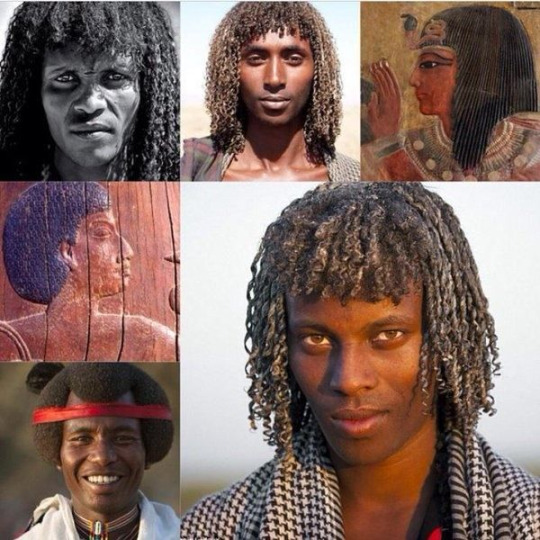
Here are some key events in Negas history:
The founding of the Ethiopian Empire in the 13th century by Yekuno Amlak.
The defeat of the Agaw by Yekuno Amlak in the 13th century.
The rise of the Zagwe dynasty in the 12th century.
The fall of the Zagwe dynasty in the 13th century.
The rise of the Solomonic dynasty in the 13th century.
The Portuguese invasion of Ethiopia in the 16th century.
The Oromo expansion into Ethiopia in the 16th and 17th centuries.
The Zemene Mesafint (Era of the Princes) in the 18th and 19th centuries.
The Battle of Adwa in 1896, in which Ethiopia defeated Italy.
The Italian occupation of Ethiopia from 1936 to 1941.
The Ethiopian Revolution in 1974.
The fall of the Negas in 1974.
#Negas#African Negas People#who are the Negas People#East African Negas#The founding of the Ethiopian Empire in the 13th century by Yekuno Amlak
4 notes
·
View notes
Text
Events 4.10
428 – Nestorius becomes the Patriarch of Constantinople.
837 – Halley's Comet makes its closest approach to Earth at a distance equal to 0.0342 AU (5.1 million kilometres/3.2 million miles).
1407 – Deshin Shekpa, 5th Karmapa Lama visits the Ming dynasty capital at Nanjing and is awarded the title "Great Treasure Prince of Dharma".
1500 – Ludovico Sforza is captured by Swiss troops at Novara and is handed over to the French.
1545 – The settlement of Villa Imperial de Carlos V (now the city of Potosí) in Bolivia is founded after the discovery of huge silver deposits in the area.
1606 – The Virginia Company of London is established by royal charter by James I of England with the purpose of establishing colonial settlements in North America.
1710 – The Statute of Anne, the first law regulating copyright, comes into force in Great Britain.
1717 – Robert Walpole resigns from the British government, commencing the Whig Split which lasts until 1720.
1741 – War of the Austrian Succession: Prussia gains control of Silesia at the Battle of Mollwitz.
1809 – Napoleonic Wars: The War of the Fifth Coalition begins when forces of the Austrian Empire invade Bavaria.
1815 – The Mount Tambora volcano begins a three-month-long eruption, lasting until July 15. The eruption ultimately kills 71,000 people and affects Earth's climate for the next two years.
1816 – The Federal government of the United States approves the creation of the Second Bank of the United States.
1821 – Patriarch Gregory V of Constantinople is hanged by the Ottoman government from the main gate of the Patriarchate and his body is thrown into the Bosphorus.
1821 – Greek War of Independence: the island of Psara joins the Greek struggle for independence.
1826 – The 10,500 inhabitants of the Greek town of Missolonghi begin leaving the town after a year's siege by Turkish forces. Very few of them survive.
1858 – After the original Big Ben, a 14.5 tonnes (32,000 lb) bell for the Palace of Westminster, had cracked during testing, it is recast into the current 13.76 tonnes (30,300 lb) bell by Whitechapel Bell Foundry.
1864 – Archduke Maximilian of Habsburg is proclaimed emperor of Mexico during the French intervention in Mexico.
1865 – American Civil War: A day after his surrender to Union forces, Confederate General Robert E. Lee addresses his troops for the last time.
1866 – The American Society for the Prevention of Cruelty to Animals (ASPCA) is founded in New York City by Henry Bergh.
1868 – At Arogee in Abyssinia, British and Indian forces defeat an army of Emperor Tewodros II. While 700 Ethiopians are killed and many more injured, only two British/Indian troops die.
1872 – The first Arbor Day is celebrated in Nebraska.
1875 – India: Arya Samaj is founded in Mumbai by Swami Dayananda Saraswati to propagate his goal of social reform.
1887 – On Easter Sunday, Pope Leo XIII authorizes the establishment of the Catholic University of America.
1896 – 1896 Summer Olympics: The Olympic marathon is run ending with the victory of Greek athlete Spyridon Louis.
1900 – British suffer a sharp defeat by the Boers south of Brandfort. 600 British troops are killed and wounded and 800 taken prisoner.
1912 – RMS Titanic sets sail from Southampton, England on her maiden and only voyage.
1916 – The Professional Golfers' Association of America (PGA) is created in New York City.
1919 – Mexican Revolution leader Emiliano Zapata is ambushed and shot dead by government forces in Morelos.
1919 – The Third Regional Congress of Peasants, Workers and Insurgents is held by the Makhnovshchina at Huliaipole.
1925 – The Great Gatsby by F. Scott Fitzgerald is first published in New York City, by Charles Scribner's Sons.
1938 – The 1938 German parliamentary election and referendum seeks approval for a single list of Nazi candidates and the recent annexation of Austria.
1939 – Alcoholics Anonymous, A.A.'s "Big Book", is first published.
1941 – World War II: The Axis powers establish the Independent State of Croatia.
1944 – Rudolf Vrba and Alfréd Wetzler escape from Birkenau death camp.
1963 – One hundred twenty-nine American sailors die when the submarine USS Thresher sinks at sea.
1968 – The TEV Wahine, a New Zealand ferry sinks in Wellington harbour due to a fierce storm – the strongest winds ever in Wellington. Out of the 734 people on board, fifty-three died.
1970 – Paul McCartney announces that he is leaving The Beatles for personal and professional reasons.
1971 – Ping-pong diplomacy: In an attempt to thaw relations with the United States, China hosts the U.S. table tennis team for a week-long visit.
1972 – Tombs containing bamboo slips, among them Sun Tzu's Art of War and Sun Bin's lost military treatise, are accidentally discovered by construction workers in Shandong.
1972 – Vietnam War: For the first time since November 1967, American B-52 bombers reportedly begin bombing North Vietnam.
1973 – Invicta International Airlines Flight 435 crashes in a snowstorm on approach to Basel, Switzerland, killing 108 people.
1979 – Red River Valley tornado outbreak: A tornado lands in Wichita Falls, Texas killing 42 people.
1988 – The Ojhri Camp explosion kills or injures more than 1,000 people in Rawalpindi and Islamabad, Pakistan.
1991 – Italian ferry MS Moby Prince collides with an oil tanker in dense fog off Livorno, Italy, killing 140.
1991 – A rare tropical storm develops in the South Atlantic Ocean near Angola; the first to be documented by satellites.
1998 – The Good Friday Agreement is signed in Northern Ireland.
2009 – President of Fiji Ratu Josefa Iloilo announces the abrogation of the constitution and assumes all governance in the country, creating a constitutional crisis.
2010 – Polish Air Force Tu-154M crashes near Smolensk, Russia, killing 96 people, including Polish President Lech Kaczyński, his wife, and dozens of other senior officials and dignitaries.
2016 – The Paravur temple accident in which a devastating fire caused by the explosion of firecrackers stored for Vishu, kills more than one hundred people out of the thousands gathered for seventh day of Bhadrakali worship.
2016 – An earthquake of 6.6 magnitude strikes 39 km west-southwest of Ashkasham, shakes up India, Afghanistan, Tajikistan, Srinagar and Pakistan.
2019 – Scientists from the Event Horizon Telescope project announce the first ever image of a black hole, which was located in the centre of the M87 galaxy.
1 note
·
View note
Text

Déjatch Alámayou, King Theodore's Son
July 1868
Julia Margaret Cameron British, born India
Déjatch Alámayou was taken to England after the British defeat of the Ethiopians at the battle of Magdala and the suicide of his father, Tewodros (Theodore) II, emperor of Ethiopia, in April 1868. Queen Victoria took an interest in Alámayou and saw to his education and protection, placing him in the care of Captain Tristram Speedy, who, like Cameron, had a home on the Isle of Wight. Speedy brought the child to Cameron’s house shortly after his arrival in England, and Cameron made ten photographs of the captain and his charge posed among Ethiopian exotica. In this image, the young orphaned prince cradles a little white doll and stares sadly into space, seemingly lost in thought. His name, Alámayou, means “I have seen the world.”
Not on view
Artwork Details
Title: Déjatch Alámayou, King Theodore's Son
Artist: Julia Margaret Cameron (British (born India), Calcutta 1815–1879 Kalutara, Ceylon)
Date: July 1868
Medium: Albumen silver print from glass negative
Dimensions: Image: 29.2 x 23.3 cm (11 1/2 x 9 3/16 in.)
Classification: Photographs
Credit Line: Gilman Collection, Gift of The Howard Gilman Foundation, 2005
Accession Number: 2005.100.239
0 notes
Text
Toy Story 3 Costumes And Easy Methods To Have A Toy Story 3 Party
One of my first memories belonging to the salvation army is a very familiar one to many workers. When I any very little girl, Was once window shopping with my mom before Christmas at Macy's Department Store on 34th Street as well as passed a Salvation Army volunteer. The volunteer was equipped by using a bell which includes kettle. malwarebytes anti-malware portable were very poor, but my mother reached into her old coat and threw several coins into the kettle.
There a lot of army clothes that happen to be in high demand amongst the buyers. Buyers prefer mostly the special type of thermal under garments. This underwear is invented of fleece and 100% polypropylene that be used even on an unpleasant condition of local climate. Thermal underwear is worn under vests and jeans. It helps to preserve the warmth of demands for an extended period of period of your time. Sweat gets absorbed and skin remains dry all time. Moreover, the anti-bacterial materials are included too in design of special types of clothes for preventing any attacks of over all skin.
By 1943, the connected with Arabian horses the army owned was second in order to the regarding Thoroughbreds they owned. Later that same year, T.K. Kellogg (an Arabian Horse Registry Director from 1927 to 1940) and Albert Harris, helped the Oughout.S. Remount Service gain possession of Mr. Kellogg's Arabian stud in Pomona California. The stud was originally inclined to the state of California, though World War II heating up, the U.S. Remount Service felt they had been need for it. In October of 1943, Mister. Kellogg was successful when you the California Board of Regents flip over the Arabian Ranch (and 97 purebred Arabian horses) to your U.S. army for use as a remount channel. The ranch was properties of the War Department from 1943-1948 and was called the Pomona Quartermaster Depot (Remount).
In October 1862 Tewodros II, emperor of Ethiopia, sent a letter to Queen Victoria inviting an partnership. The letter was ignored by the British . As there was no reply throughout the British government, the Ethiopian emperor imprisoned some Europeans and he British envoy in wrath. This led to the expedition.
Career Healthcare professional. Once you've been accepted stored on your medical paperwork, the next step is watching a career counselor. malwarebytes anti-malware latest version download will offer you with a list of options that you will be qualified to receive. You can choose one or ask the career counselor if you might be qualified further job that you have looked around. You may not be qualified for the first choice of job, or there sure isn't a slot available in the interim. If malwarebytes anti-malware free that you are contemplating isn't there, then walk out or pick another slot that interest's you probably the most. Also, getting a job is determine by your score more than a ASVAB test and if you are entitled for a bonus.
In which way seem at it, the fact still remains: army games are enjoyment. If however, modern army games are not your thing, you can try a far more medieval version in fighting off enemies and conquering cities in Crush the Castle 2. In this particular game, instead of being the defender, you will be the attacker and destroyer of locations. Isn't that cool already? Merely that, additionally, you will be forwarded to ultimate weapon of period (and no, I'm not talking about guns here)- I'm covering the trebuchet!
Some analysts apparels are sold internet based. There are a lot of sites that sells Army clothing at a very reasonable price with top quality. Details are also provided so you don't need to worry. The website is made to answer all the questions that you are able to possible consult.
1 note
·
View note
Text
Extra! Further! Read All About It! God's Army Being Fully Mobilized!
The utterance of the term Swiss Army reminds you of the knife. Obviously so mainly because Swiss Army knife is the most popular item marriage chocolates that initiated from that place.
Being much simpler and creative, some people may not expend on these watches because excellent neat easy and not showy. However, they have great sophistication in there engineering knowning that gives it an edge over some other people.
The Swiss watch stands shoulder to shoulder while using Swiss army knife in relation to of its quality of engineering and durability factor. But unlike the knife which comes filled with the sorts of accessories, the Swiss army pocket knife is bare minimal. An individual are into flashy watches then this watch will seem for you to become a tad bit too plain for you.
In October 1862 Tewodros II, emperor of Ethiopia, sent a letter to Queen Victoria soliciting for an partnership. The letter was ignored by the British lawmakers. As there was no reply out of your British government, the Ethiopian emperor imprisoned some Europeans and he British envoy in animosity. movavi video editor crack led to the expedition.
The entire charge among the expedition was presented with to the British Indian Army. Sir Robert Napier was appointed as the commander for your operation. The commander estimated that there would be a requisite of 12000 soldiers. From India, nearly 13000 troops were sent. 8000 laborers and significant horses, associated with camels and elephants were also sent for purpose.
Men and ladies have different sets of styles. However, I've seen few girls who didn't mind wearing men's military tee shirts. They do look and fit well put together. The good thing continually that both genders won't see it rather hard to choose, the way they come in unisex. You will just to be able to decide what shape or size you propose to work with.
I am not suggesting that all instructors who advertise their army roots are martial klutzes - not likely it. However it "is" important not with regard to fooled through the term "army training." Towards people, it is able to imply well. amateur.
1 note
·
View note
Link
Tewodros II (Ge'ez: ቴዎድሮስ, baptized as Sahle Dingil, English: Theodore II; c. 1818 – April 13, 1868) was Emperor of Ethiopia from 1855 until his death in 1868. He was born Kassa Hailegiorgis (Ge'ez: ካሳ ኃይሉ; English: "restitution" and "His [or the] power"). His rule is often placed as the beginning of modern Ethiopia, ending the decentralized Zemene Mesafint (Era of the Princes).
Tewodros II's origins were in the Era of the Princes, but his ambitions were not those of the regional nobility. He sought to reestablish a cohesive Ethiopian state and to reform its administration and church. He sought to restore Solomonic hegemony, and he considered himself the Elect of God.
2 notes
·
View notes
Photo

Alemayehu Simyen Tewodoros, Prince of Ethiopia (AD 1861 – 1879)
1 note
·
View note
Text
One of the more ghoulish practices of colonialism is its habit of keeping literal body parts of the people who died fighting it
Emperor Tewodros II of Ethiopia, one of the founding fathers of the contemporary Ethiopian state, is one such figure. The British indulged in this practice as a result of a victory won against him because he proved too assertive for their liking, and only in this century has the contemporary UK decided to belatedly reverse this.
This is also one of the major reasons why the racist stereotypes colonialism dealt to Africans is in many ways more projection than the people who take those myths as a given would ever admit voluntarily.
#lightdancer comments on history#colonialism and its horrors#african history#ethiopian history#black history month#emperor tewodros ii
5 notes
·
View notes
Text
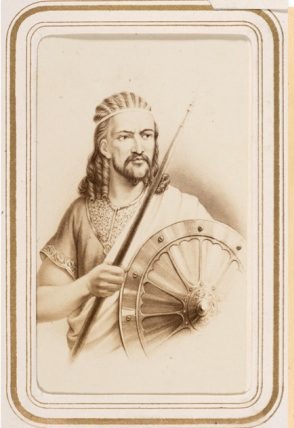
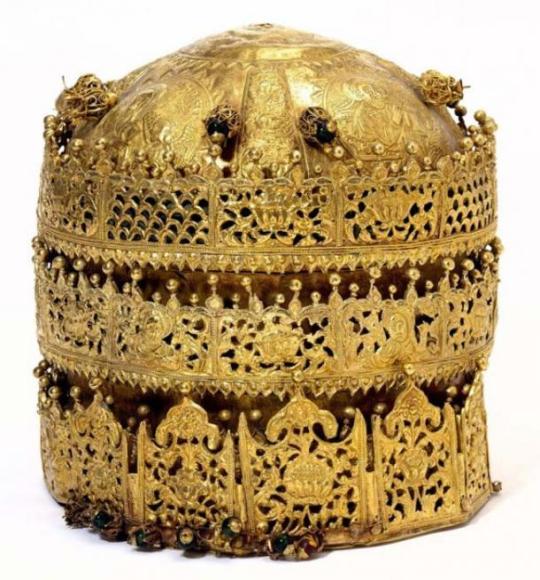
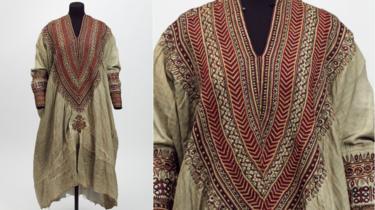


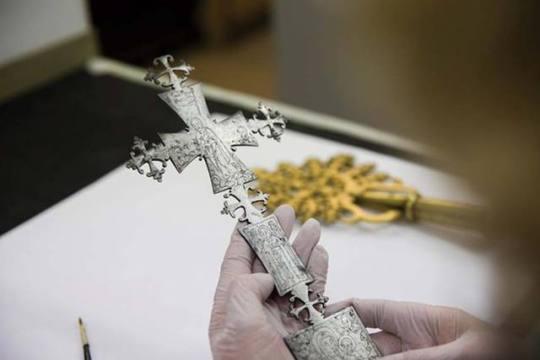
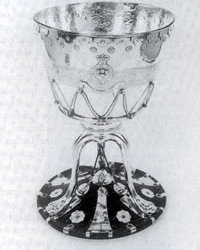


1868 Abyssinian Expedition: The Battle of Maqdala.
The Maqdala expedition ended with the suicide of Atse Tewodros II and the British forces looting many hundreds of artifacts worth millions of dollars from the mountain-top fortress. Imperial treasures and sacred religious manuscripts, including tabots, were auctioned off for British military funding.
The last photo is of the son of Emperor Tewodros II, Prince Alemayehu, who was orphaned at age 7. As per his father's wishes, the prince was taken in by English protection and Queen Victoria. He died at age 19. His remains have not been repatriated.
Photos include: portrait of emperor Tewodros II, a gold crown, a royal dress and necklace (said to have belonged to the Empress Tirunesh, widow of Tewodros'), processional crosses (usually only carried by priests), a war drum, religious manuscript (Homilies on the Archangel Michael), and portrait of Prince Alemayehu with his British gaurdian (Captain Speedy). Despite numerous demands for restitution, the items remain in European custody.
#ethiopian history#ethiopian heritage#maqdala#ethiopian royalty#african history#east africa#ethiopia#abyssinia#emperor#archeology#mobile upload#m#colonialism#atse tewodros II#war history
10 notes
·
View notes
Photo

Ethiopian Emperor Tewodros II: UK to return stolen hair http://bit.ly/2SDYeUx
1 note
·
View note
Text
The Abyssinia Expedition
From the National Army Museum.

From 1855, Abyssinia in east Africa had been ruled by Tewodros II (or Theodore), a Coptic Christian ruler. He had established his rule through war, defeating his rivals, but he also continued to face many internal rebellions as he tried to enforce his rule.
In 1862 he had asked the British Government for an alliance and assistance in acquiring the latest weapons and tactical experts to help him, as a Christian ruler, in his wars with his mostly Muslim neighbours.
Hostages
But his request went unanswered. The following year, enraged by the Foreign Office’s failure to reply, he seized a number of European hostages. Among them was the British Consul, Captain Charles Cameron, who was kept in chains for over two years. The hostages’ conditions of captivity varied greatly as the unstable Theodore tended to treat them alternately with kindness and cruelty according to his mood.
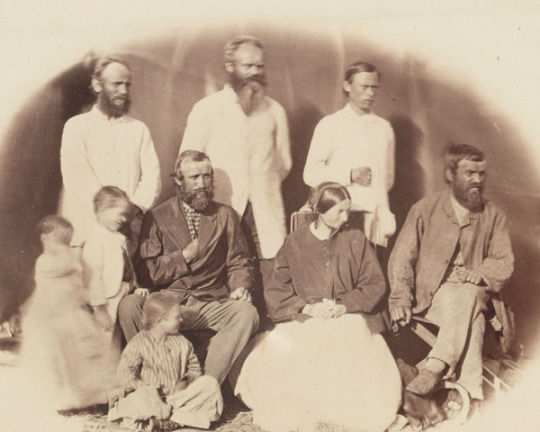
Outcry
Captain Cameron wrote to the British press describing what was happening. This, and the fact that British women and children were numbered amongst the hostages, created a public outcry that forced the government into a response.
Initial diplomatic negotiations and numerous gifts failed to secure their release. By June 1867, in the face of mounting public indignation, the British reluctantly concluded that military intervention was necessary.
‘There has never been in modern times a colonial campaign quite like the British expedition to Ethiopia in 1868. It proceeds from first to last with the decorum and heavy inevitability of a Victorian state banquet, complete with ponderous speeches at the end. And yet it was a fearsome undertaking; for hundreds of years the country had never been invaded, and the savage nature of the terrain alone was enough to promote failure.’ Alan Moorehead, war correspondent and author, 1962
The 'British' Army responds
As a response was planned, it was made clear that this was not simply a mission of conquest. Once the hostages were freed and Theodore punished, the military force was to withdraw. There was never any intention of adding Abyssinia to the Empire.
Instead of sending soldiers from Britain, the force despatched was drawn from the Bengal and Bombay Armies - usually used to maintain British control in India. It was therefore made up of both British regiments serving in India and locally-recruited Indian soldiers.
The army was commanded by Lieutenant-General Sir Robert Napier, a Royal Engineer. It was the first time that an engineer had commanded an expedition.
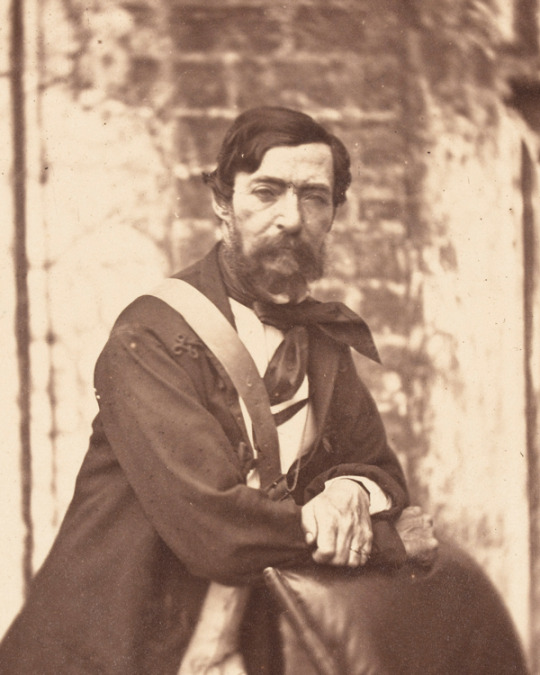
Sir Robert Napier, 1858
Expeditionary force
Napier's army was loaded on to ships in Bombay. 13,000 soldiers were sent along with 40,000 animals, including 44 elephants trained to pull the big artillery guns.
The troops sailed from Bombay on 21 December 1867 and crossed the Arabian Sea, before navigating the Red Sea to the Gulf of Zula, in modern day Eritrea. They established a base camp, from where they would march inland.
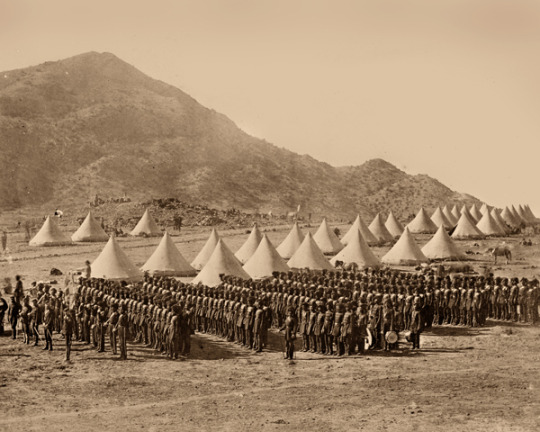
The 127th Baluch Light Infantry formed up in camp in Abyssinia, 1868
Logistics
Napier’s ability to overcome the logistical challenges that faced his soldiers was essential in the campaign. From the very beginning, supplies had to be moved from India to the landing area at Zula on the coast.
Once they had been consolidated there, the British forces would have to cross 400 miles of mountainous terrain in inhospitable weather conditions to reach Theodore’s fortress at Magdala. As an engineer, Napier had a keen appreciation of the difficulties this posed.
Innovation
To reach Magdala, Napier used many technical innovations to keep the army moving and supplied, including the telegraph and desalination plants to turn sea water into fresh water. A harbour was built with piers and warehouses to help unload and store supplies. Twenty miles of railway line were laid, complete with locomotives brought from India.
The Royal Engineers built a road into the interior of the country to help the army move quicker. Speed was a factor, as the campaign needed to be completed before the torrential June rains made the already challenging terrain utterly impassable.
The advance began on 26 January, and was combined with diplomatic efforts, as the British secured agreements with Theodore’s enemies to cross their territory without encountering armed opposition. This would also protect lines of communication and supply.
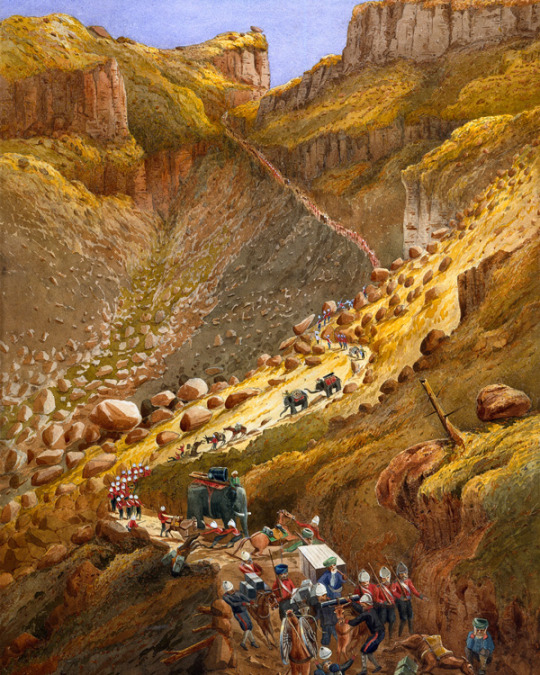
British troops negotiate the steep Chetta Ravine, 1868
At Magdala’s gates
Napier's diplomacy ensured that the British were able to march freely across northern Abyssinia, but it still took over two months to reach Magdala. Theodore’s capital was built on top of a volcanic plug that towered over the local landscape.
But before the British could assault it they needed to cross the plateau of Arogye. Theodore’s army, including 30 artillery pieces, was encamped around it in defensive positions, which the British would have to battle through.
Attack
On 10 April Theodore ordered his army to attack, rather than hold their positions, in an effort to seize the initiative. They were ill-equipped, and the British and Indian soldiers drove them back into Magdala. The battle lasted just 90 minutes. More than 500 Abyssinians were killed and thousands more wounded. The British suffered a mere handful of injuries.
The following day, the British moved to attack Magdala. Theodore released all his European hostages over the next two days and murdered the others he was holding, but refused to surrender.
On 13 April, the British attacked the fortress. An artillery bombardment covered the advance up the narrow route to the entrance. Once there, the British rushed the outer and inner gates under fire.
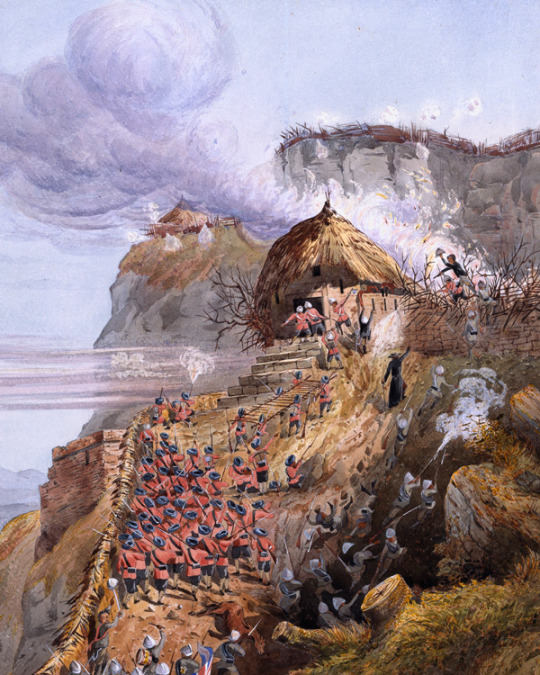
Troops storming the gateway at Magdala, 13 April 1868
Suicide
As the British moved into the fortress they discovered the body of Theodore just inside the second gate. Rather than be captured, he had committed suicide with a pistol that had been a gift from Queen Victoria. As news of his death spread, all resistance from the defenders came to an end.
Napier's Anglo-Indian army had won, and the campaign had cost just 18 wounded and two killed. No accurate record of how many Abyssinian casualties were sustained was taken.
'The End of King Theodore', based on a sketch by William Simpson who accompanied the 1868 expedition
‘The roll of the drum assembled all the officers and crowds of onlookers around the piled treasures of Magdala, which covered half an acre of ground… Bidders were not scarce. Every officer and civilian desired some souvenir of Magdala.’Journalist and explorer Henry Morgan Stanley recalling the British auction of treasures following the capture of Magdala , 1896
Aftermath
Napier destroyed Theodore’s artillery and the fortress, but not before allowing his troops to pillage Magdala. An enormous auction of loot was then held. It took 15 elephants and nearly 200 mules to carry it back to the coast.
During the long march to the coast Napier's men faced small attacks from various tribes. For those allies that had granted free passage, however, gifts were made of weaponry. Napier reached Zula on 2 June, and his troops soon dismantled the base camp, eroding virtually all trace of their presence. On 10 June Napier sailed for Britain.
The expedition was hailed as a success by a British public that had demanded action. Napier was made Baron Napier of Magdala by Queen Victoria. The soldiers who took part were awarded the Abyssinian War Medal and the battle honour ‘Abyssinia’ was granted to the regiments involved.
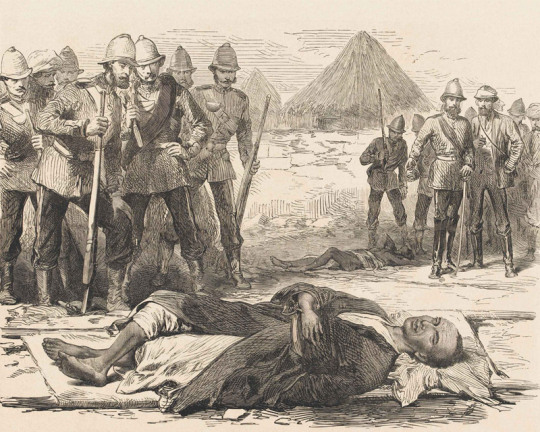
#abyssinia#abyssinia expedition#abyssinian expedition#abyssinia campaign#abyssinian campaign#british army#british empire#history#military history#19th century#redcoat#redcoats
147 notes
·
View notes
Text
Events 4.10 (before 1920)
428 – Nestorius becomes the Patriarch of Constantinople.
837 – Halley's Comet makes its closest approach to Earth at a distance equal to 0.0342 AU (5.1 million kilometres/3.2 million miles).
1407 – Deshin Shekpa, 5th Karmapa Lama visits the Ming dynasty capital at Nanjing and is awarded the title "Great Treasure Prince of Dharma".
1500 – Ludovico Sforza is captured by Swiss troops at Novara and is handed over to the French.
1545 – The settlement of Villa Imperial de Carlos V (now the city of Potosí) in Bolivia is founded after the discovery of huge silver deposits in the area.
1606 – The Virginia Company of London is established by royal charter by James I of England with the purpose of establishing colonial settlements in North America.
1710 – The Statute of Anne, the first law regulating copyright, comes into force in Great Britain.
1717 – Robert Walpole resigns from the British government, commencing the Whig Split which lasts until 1720.
1724 Bach leads the first performance of his cantata Erfreut euch, ihr Herzen, BWV 66, his first cantata composed for Easter in Leipzig.
1741 – War of the Austrian Succession: Prussia gains control of Silesia at the Battle of Mollwitz.
1809 – Napoleonic Wars: The War of the Fifth Coalition begins when forces of the Austrian Empire invade Bavaria.
1815 – The Mount Tambora volcano begins a three-month-long eruption, lasting until July 15. The eruption ultimately kills 71,000 people and affects Earth's climate for the next two years.
1816 – The Federal government of the United States approves the creation of the Second Bank of the United States.
1821 – Patriarch Gregory V of Constantinople is hanged by the Ottoman government from the main gate of the Patriarchate and his body is thrown into the Bosphorus.
1821 – Greek War of Independence: the island of Psara joins the Greek struggle for independence.
1826 – The 10,500 inhabitants of the Greek town of Missolonghi begin leaving the town after a year's siege by Turkish forces. Very few of them survive.
1858 – After the original Big Ben, a 14.5 tonnes (32,000 lb) bell for the Palace of Westminster, had cracked during testing, it is recast into the current 13.76 tonnes (30,300 lb) bell by Whitechapel Bell Foundry.
1864 – Archduke Maximilian of Habsburg is proclaimed emperor of Mexico during the French intervention in Mexico.
1865 – American Civil War: A day after his surrender to Union forces, Confederate General Robert E. Lee addresses his troops for the last time.
1866 – The American Society for the Prevention of Cruelty to Animals (ASPCA) is founded in New York City by Henry Bergh.
1868 – At Arogee in Abyssinia, British and Indian forces defeat an army of Emperor Tewodros II. While 700 Ethiopians are killed and many more injured, only two British/Indian troops die.
1872 – The first Arbor Day is celebrated in Nebraska.
1875 – India: Arya Samaj is founded in Mumbai by Swami Dayananda Saraswati to propagate his goal of social reform.
1887 – On Easter Sunday, Pope Leo XIII authorizes the establishment of the Catholic University of America.
1896 – 1896 Summer Olympics: The Olympic marathon is run ending with the victory of Greek athlete Spyridon Louis.
1900 – British suffer a sharp defeat by the Boers south of Brandfort. 600 British troops are killed and wounded and 800 taken prisoner.
1912 – RMS Titanic sets sail from Southampton, England on her maiden and only voyage.
1916 – The Professional Golfers' Association of America (PGA) is created in New York City.
1919 – Mexican Revolution leader Emiliano Zapata is ambushed and shot dead by government forces in Morelos.
1919 – The Third Regional Congress of Peasants, Workers and Insurgents is held by the Makhnovshchina at Huliaipole.
0 notes
Photo
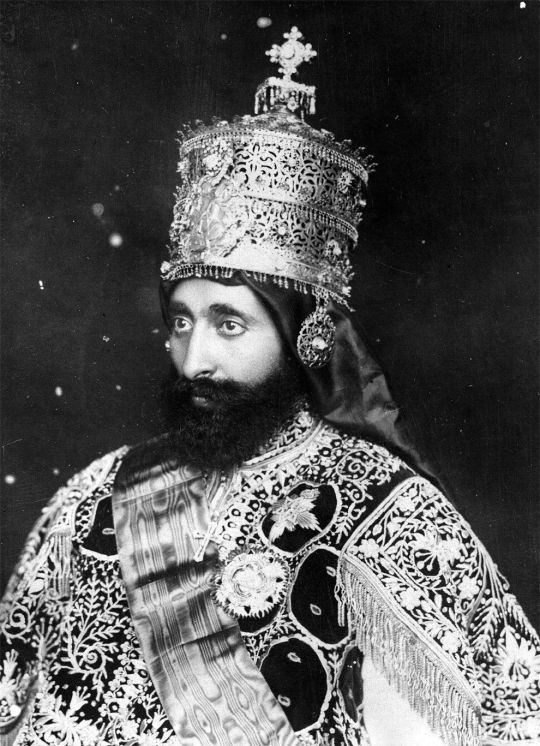
Who was the king of Ethiopia before Haile Selassie?
The title used by Haile Selassie actually translates as 'King of Kings', and thus was usually rendered in English as 'Emperor' rather than 'King'.
The previous monarch before him was a Queen (or Empress) not a King: Zewdita, who ruled from 1917 to 1930. Before her came her nephew Iyasu, who was never actually crowned so is usually not included in the list of emperors. Before him came Emperor Menelik II, who ruled from 1889 until 1913, but his death was not publicly announced until 1916.
In Amharic, the title was Negus Negusti, or in Ge'ez (the traditional language of Ethiopia still used for ritual and sacred purposes) Negusa Negest. 'Negus' is pronounced with the stress on the second syllable, which is long, so something like ne-GOOSE. It is usually translated into English as 'King'. It should also be noted that Ethiopia does not use the Latin alphabet, so Amharic and Ge'ez words are often transliterated into English in different ways (such as negusti, naguste, etc).
For much of its history, Ethiopia was a collection of rival kingdoms such as Shewa, Gojjam, Wollo, and Begemder, whose rulers often used the title Negus or King. Meanwhile the Solomonic dynasty claimed to rule the whole country by the right of their descent from Menelik, the supposed son of Solomon and the Queen of Sheba. Members of the dynasty called themselves Kings of Kings. Sometimes they had real power and the country had a centralised government; at other times there were merely figureheads while the various provincial kings were practically independent.

The period from 1769 to 1855 was one of those times of division with no real central government: it is known as the Zemene Mesafint or 'Age of Princes'. No fewer than 23 different Emperors were crowned during this period, but none of them had much actual power. That changed with the rise to power of Kassa Haile, son of a minor nobleman from the Dembiya province. Disinherited and reduced to outlawry — popular legend speaks of him as a Robin Hood-like figure, stealing from the rich and helping the poor — he formed an army and eventually seized control of Dembiya for himself.
Kassa attracted the attention of the powerful noble Ali of Yejju, whose mother Menen had married the nominal emperor and who himself claimed to be the Imperial Regent. In order to make this up-and-coming young warlord an ally, Ali arranged for him to marry his daughter Tewabech in 1848. While Kassa and Tewabech had a happy marriage, he soon quarrelled with his in-laws, and by 1852 was in armed rebellion against them.
Kassa defeated both his father-in-law and several other rival nobles, and by 1855 was the strongest ruler in Ethiopia. He then forced the nominal Emperor Yohannes III to abdicate, and had himself crowned Negus Negusti on 11 February 1855. He changed his name to Tewodros ('Theodore') which sounded more imperial, and spread the story (which may or may not be true) that his mother was descended from a 17th-century Emperor of Ethiopia and thus he himself had the blood of the Solomonic dynasty in his veins.

For the first time in a century Ethiopia was united by an Emperor who had actual power. Tewodros II (there had been a previous Tewodros in the 15th century) ruled for 13 years and spent much of that time leading an army, forcing the semi-independent rulers of Gojjam, Tigray, Shewa, and Wollo to recognise his authority. As well as constant civil wars he was threatened by the expansionist Egyptian khedivate, the Ottoman Empire, and neighbouring Muslim kingdoms.
In 1862 Tewodros decided to ask the British Empire for help modernising his kingdom. However, the British did not want to get involved in the region, and did not take his request seriously. Outraged by this dismissal, Tewodros ordered all the British citizens in his country to be arrested and thrown in prison. When he heard that a Church of England missionary had written a book describing Emperor Tewodros as 'barbaric, cruel, and unstable' he flew into a rage, personally threatened the missionary with a gun, and then beat two of his servants to death with his own hands.
The British response to the imprisonment of their citizens (including their ambassador) has been described as "one of the most expensive affairs of honour in history." They organised an army 13,000 strong, invaded Ethiopia (in January 1868), defeated its army, conquered it, and set the British prisoners free. Then, mission accomplished, they turned around and went back home again, leaving Ethiopia to its own devices. As for Emperor Tewodros, he shot himself when the British soldiers broke through the gates of his fortress.
The death of the Emperor left a power vacuum in Ethiopia, triggering four years of civil war. His immediate successor as Negus Negusti took the throne-name Tekle Giorgis II and attempted to consolidate power by offering concessions to the Ethiopian Church; but few of his rival nobles recognised his claim to the throne. Tekle Giorgis ruled for only three years before being defeated in battle by the warlord of Tigray province, who had him blinded and thrown in prison to die.
The new ruler was Kassa Mercha, another son of a minor noble who had fought his way to control of a province. When the British invaded in 1868 Kassa had helped them pass through his lands in Tigray rather than fighting them, and in return the British gave him enough modern muskets to equip 800 men, plus a battery of artillery. It was with these modern troops, plus around 11,000 more traditionally-equipped warriors, that Kassa defeated the 60,000-strong army of Emperor Tekle Giorgis at the Battle of the Assem on 11 July 1871.
After mopping up several other rivals, Kassa had himself crowned as King of Zion and King of Kings of Ethiopia (Nagusä Sayon, Nəgusä Naguśt zä Ityopya) on 21 January 1872. He took the regnal name Yohannes IV, and ruled for 17 years. He was a strong ruler who continued the work begun by Tewodros II of attempting to unite the rebellious provinces under central control, and also expanding the borders of Ethiopia outwards by conquest. A major blow to his ambitions was when the Italians seized control of the port of Massawa, previously controlled by Egypt, in 1885 — Yohannes had hoped to acquire the city himself.

Emperor Yohannes IV was killed in battle in 1889 when the Mahdists of Sudan, who believed their leader was the prophesised Messiah, invaded Ethiopia. As he lay dying in his tent he declared that his nephew Mengesha was actually his son, and so should succeed him to the throne. However, few people believed this claim and even fewer were willing to accept Mengesha as their emperor; so he was never crowned. He did, however, continue to rule his father's lands in Tigray.
The next emperor was instead Sahle Maryam, who took the throne as Menelik II. He was the illegitmate son of the negus of Shewa province, and was taken prisoner when Emperor Tewodros II subdued Shewa and reincorporated it into his empire. However, Tewodros took a liking to Sahle and arranged for him to marry his daughter. In 1865 Sahle seized control of Shewa for himself. He remained neutral during the British invasion of 1868, helping neither his father-in-law the Emperor nor the British. While Yohannes ruled, Sahle remained mostly quiet, though he showed great interest in modernising his province and especially its army with Italian help.
He declared himself as rightful emperor under the new name Menelik as soon as Yohannes died, because unlike the previous few monarchs, he was directly descended in the male line from the House of Solomon. Most nobles accepted his claim and he was crowned on 3 November 1889. He would rule for 24 year

born Sahle Maryam, 1889–1913
Menelik II consolidated power in Ethiopia, establishing a new capital city at Addis Ababa with modern enhancements such as paved roads, plumbing, a bank, and a post office; and in 1894 he invited the French to build a railway to connect the city to the French-controlled port of Djibouti. He also more than doubled the size of Ethiopia, by conquering the tribal lands to the south and east of his empire in a series of brutal wars. However, he is probably most famous for defeating the attempted Italian conquest of Ethiopia in 1895-96.
When he took the throne in 1889 Menelik had signed a treaty with Italy in which he recognised their ownership of Massawa and Eritrea in return for their acknowlegement of his position as Emperor. The treaty also guaranteed the freedom of both countries to trade in each others' territory and enjoy equal rights for their citizens there. However, this agreement, the Treaty of Wuchale, contained a clause that was different in the Italian and Amharic versions. The Amharic text said that the Emperor of Ethiopia could use the services of the Italian government when conducting negotiations with other nations. The Italian text said that the Emperor must use those services.
In other words, the Italian version of the treaty — which the Italian government circulated to other European nations — made Ethiopia their protectorate, conducting its foreign policy only with Italian permission. The Amharic wording suggested that this was merely optional, and that the Ethiopians could simply ask for Italian help and advice when negotiating with Western countries. It is thought that the discrepancy was included, on his own initiative, by the Italian ambassador in Ethiopia, Count Antonelli, who wrote the text of the treaty.
Emperor Menelik did not discover this deception until 1890, when he wrote letters to Queen Victoria of the UK and Kaiser Wilhelm II of Germany, only to have them returned with a note that he was not allowed to do this, and should communicate with them only via Italy in future. (Supposedly Victoria's answer was cool but polite, Wilhelm was rude and dismissive.) Menelik was outraged, but it was not until 1893, when he felt his domestic position was secure, that he denounced the treaty. Italy, in turn, saw this defiance as justification for war.
In December 1894 fighting broke out between Italian forces in Eritrea and the inhabitants of Tigray, ruled by Mengesha, the "son" (or nephew) of Emperor Yohannes whom Menelik had beaten to the throne in 1889. The Italians won a swift victory and captured Adwa, the capital of Tigray. This encouraged them into overconfidence, and they decided to invade and conquer the rest of Ethiopia. This proved a disastrous failure.
On 1 March 1895 an Italian army of 14,519 men attacked an Ethiopian army of about 100,000 men in the Battle of Adwa (or Adowa), and was almost wiped out, losing 7,000 killed, 1,500 wounded and 3,000 captured. News of the defeat caused riots in Italy and the collapse of the government there. The new Italian government quickly signed a treaty under which they recognised Ethiopia's independence after all, and paid an indemnity of 10 million lire, in return for peace (and Ethiopia's recognition of the new border with Eritrea).
Menelik suffered a stroke in 1909, at the age of 65, which left him incapable and paralysed. His (third) wife Taytu, who had a strong personality, effectively ruled the country for a year until she was forced from power and replaced by a Council of Regency which governed from 1910 until Menelik died in 1913.
Menelik had no children from his three marriages, but he did have at least three illegitimate offspring. In 1909 he nominated his 14-year old grandson Kifle Yaqob, son of his eldest illegitimate daughter, as his heir. In 1911, with his grandfather still alive but unable to rule, his teenage grandson took power under the name of Iyasu. His title was Lij, literally meaning 'child [of noble blood]': 'Prince' might be an appropriate English translation in this context. ('Infante' would be even closer if we were speaking Spanish.)
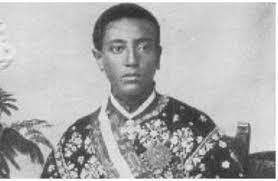
Prince Iyasu, uncrowned ruler of Ethiopia 1911–16
Lij Iyasu faced multiple challenges to his rule, including an attempted coup, a poisoning attempt, and an armed mutiny in his first year in power. He was also accused of neglecting his duties and engaging in scandalous behaviour, including leading his bodyguards in slave-raids against neighbouring states instead of remaining in the capital.
In December 1913 Menelik finally died, though this fact was kept hidden to avoid instability. The nobles and ministers of the court, who regaded Lij Iyasu as an incompetent brat, avoided having him crowned as Emperor. On 27 September 1916 the Minister of War, Habte Giyorgis Dinagde, organised a coup d'état. He produced witnesses claiming that Iyasu had secretly converted to Islam, which would be grounds to forfeit the throne; and under pressure the Church confirmed this claim, excommunicated Iyasu and released the Ethiopian nobles from their oaths of loyalty.
A brief civil war followed, and Iyasu's side lost. He fled into hiding in the desert for five years, being captured in 1921 and kept under house arrest. When Emperor Haile Selassie took the throne in 1930, as described below, Iyasu was treated more harshly. When the Italians invaded again in October 1935 they distributed propaganda urging the Ethiopians to rise up in support of "the true Emperor Iyasu V" to overthrow Haile Selassie. Purely by coincidence, the 40-year old Iyasu was shortly afterwards found dead in his cell; having died entirely of natural causes and certainly not murdered on the Emperor's orders as a potential threat.
Going back to 1916, however, the organisers of the coup decided to make Zewdita the new monarch. She was an illegitimate daughter of Emperor Menelik II, and thus the aunt of Lij Iyasu. She was also the first regnant Empress of Ethiopia, and the first female African monarch in several centuries. Her title, rather than 'King of Kings', was 'Queen of Kings' (Negiste Negest). However, as a woman it was agreed that her relative Tafari Makonnen (who was also her heir since she had no surviving children of her own) would act as her regent and plenipotentiary, the Balemulu 'Inderase. Empress Zewdita was not entirely a figurehead — she had the final decision-making power and a lot of political influence — but her kinsman was the public face of the government.
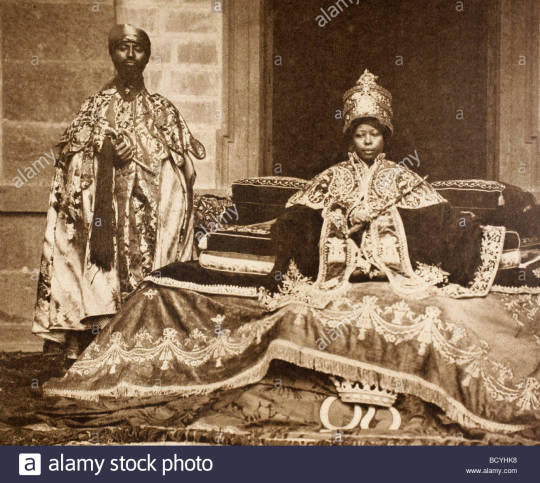
Empress Zewdita, 1917–30
Empress Zewdita was crowned on 11 February 1917 and ruled for 13 years. She was conservative and a traditionalist, and a patron of the Church in Ethiopia. She left most matters of government in the hands of her relative the Regent Plenipotentiary, Tafari Makonnen.
This regent’s father Ras Makonnen ('ras' is a noble title, roughly equivalent to duke) was the first cousin of Emperor Menelik II on his mother's side, and was appointed as governor of Harar by the Emperor. He was also a notable military commander at the Battle of Adwa. Makonnen's son Tafari, born in 1892, thus had royal blood, and it was agreed in 1917 that he would be the nominated successor to the childless Empress Zewdita. He was also given the title ras at this point.
Ras Tafari thus became the face of the Ethiopian government in the name of the Empress. He arranged for his country to join the League of Nations in 1923, and pursued a cautious strategy of modernisation and westernisation. He also banned slavery in his country, though he was unable to enforce this.
In 1928 there was an attempted revolt against Tafari's power, led by the governor of Sidamo province who was accused of underpaying taxes to the central government. Conservative nobles rallied around the Empress and attempted to have Tafari tried, for treason and consorting with Italians. The attempt failed, and as a concession to secure peace Empress Zewdita was pressured into upgrading Tafari's title from Ras to Negus, or 'king'.
Two years later the Empress's husband Gugsa Welle launched a rebellion of his own against Negus Tafari — without the permission of his wife. He raised an army of around 35,000 men, but other members of the nobility were too cautious to join him. The Empress reluctantly declared her husband a rebel, and Tafari led the official army of Ethiopia to combat him at the Battle of Anchem on 31 March 1930. Three aircraft flew over the rebel army dropping leaflets urging the soldiers to desert, followed by bombs. Gugsa Welle himself was shot and killed while riding a white horse into battle. His army disintegrated. Within three days, Empress Zewdita herself was dead, supposedly of shock and grief at her husband's death (though she was in fact seriously ill anyway).
Eight months later on 2 November 1930 Tafari Makonnen was proclaimed as Emperor himself, taking the name Haile Selassie (which means 'Power of the Trinity'). He remained emperor until the revolution of 1974, though between 1936 and 1941 he was in exile in England after the Italian conquest of his country
A major famine in 1972-74 which killed tens of thousands of people (some sources claim even higher figures) undermined public support for the Emperor, who until then had generally been popular. High inflation also led to riots, strikes, and a mutiny by the army which demanded higher pay. On 12 September 1974 a Committee (Derg in Ge'ez) set up to investigate and rectify the army's grievances, instead deposed the Emperor and placed him and his family under arrest.
Haile Selassie's son, the 58-year old Crown Prince Asfaw Wossen, was in Switzerland at the time receiving medical treatment. The military junta announced that he was now King of Ethiopia (they used the term 'King', not 'Emperor'). However, Asfaw refused to accept the legitimacy of the coup against his father, and therefore refused to use the new title given to him. He also publicly condemned the actions of the Derg when they had about 60 high-ranking members of the government executed by firing squad. In March 1975 the Derg — officially known as the Provisional Military Administrative Council — therefore announced the abolition of the monarchy and declared the creation of a Marxist-Leninist socialist republic.
The last reigning emperor, 83-year old Haile Selassie, died on 27 August 1975, supposedly of complications following surgery but according to some, he was strangled.
556 notes
·
View notes